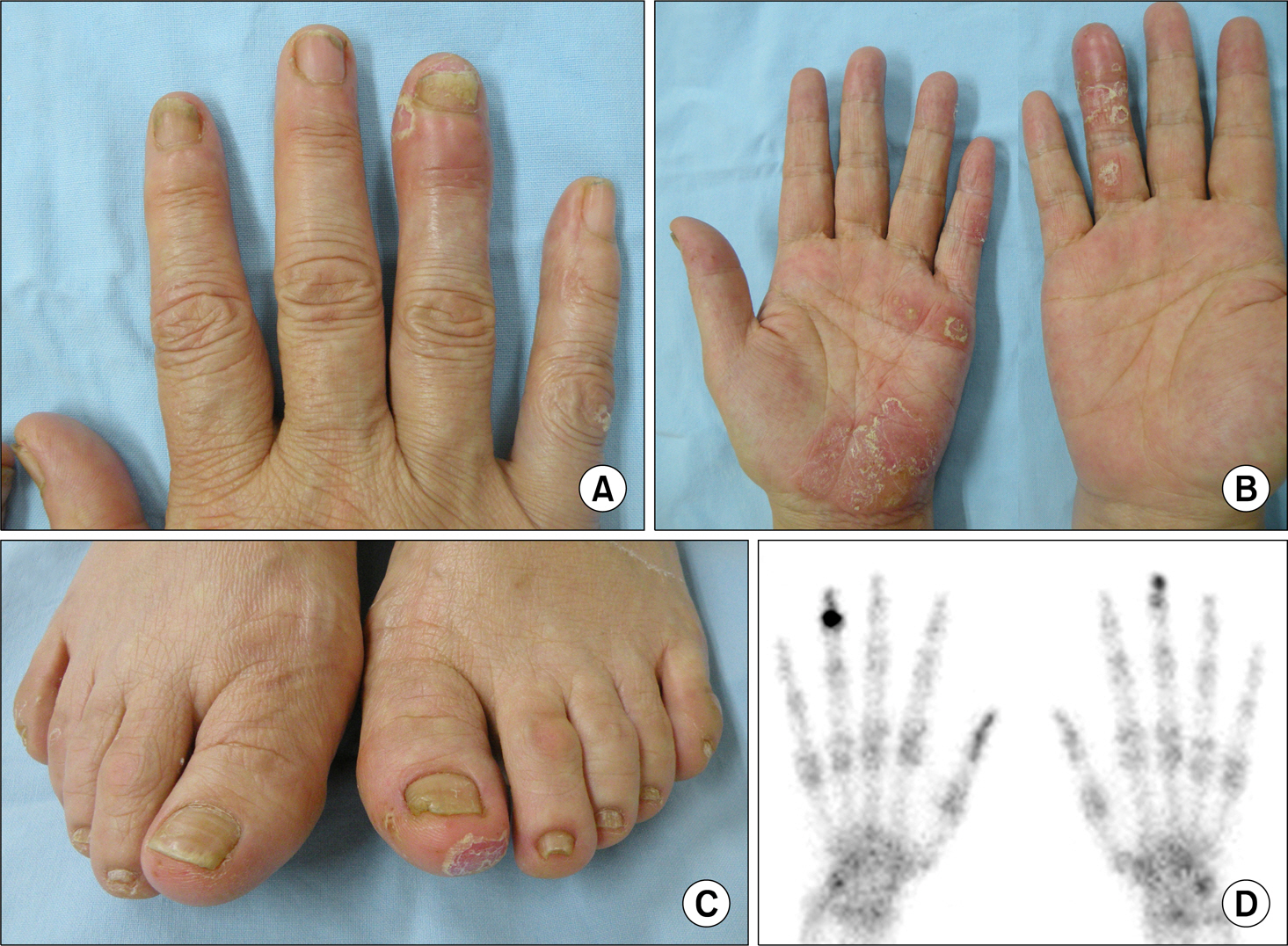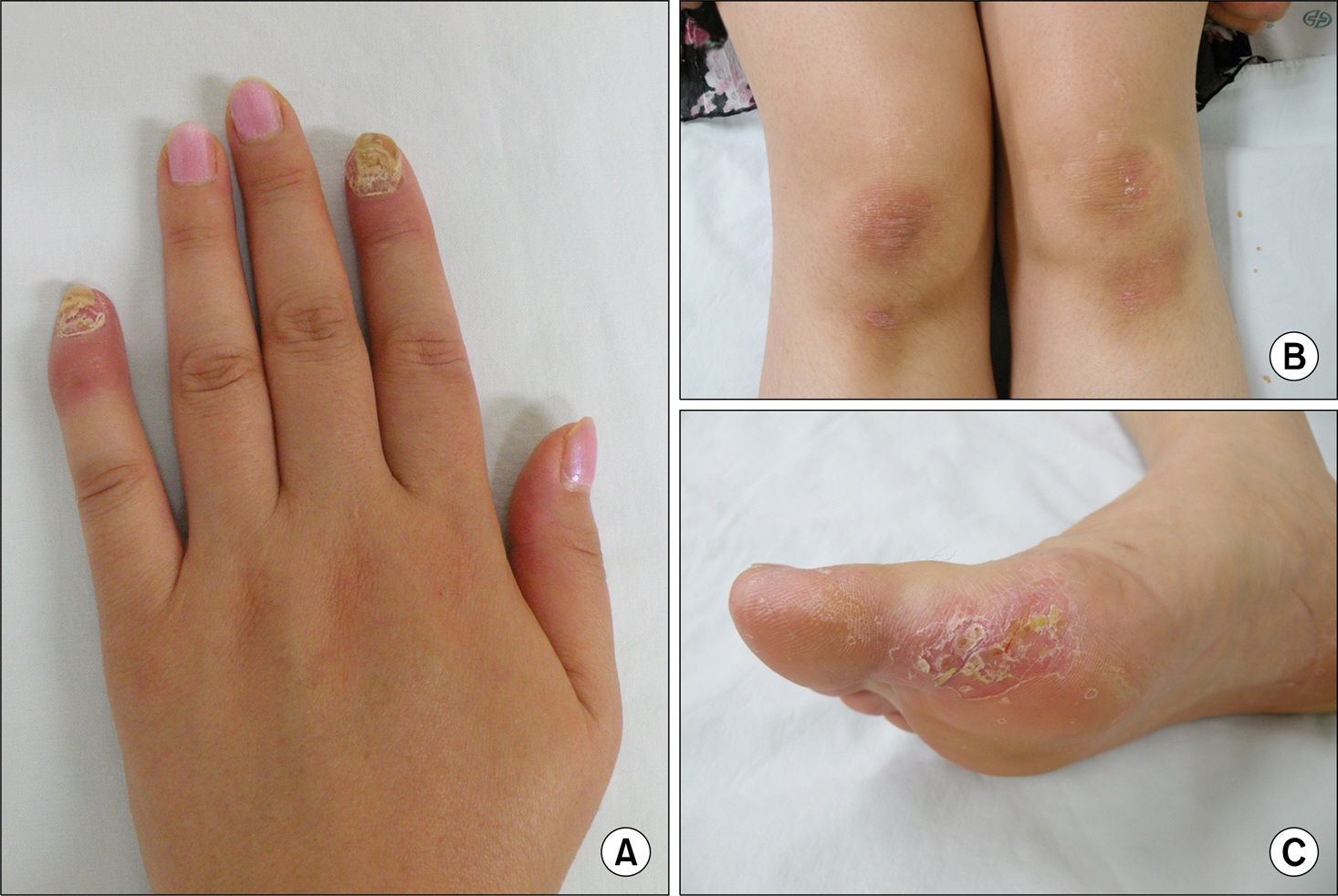J Rheum Dis.
2015 Feb;22(1):45-50. 10.4078/jrd.2015.22.1.45.
Psoriatic Onycho-pachydermo-periostitis of the Fingertips: A Report of Two Cases
- Affiliations
-
- 1Department of Internal Medicine, Daegu Fatima Hospital, Daegu, Korea. kiefe73@gmail.com
- 2Department of Orthopedic Surgery, Daegu Fatima Hospital, Daegu, Korea.
- KMID: 2222927
- DOI: http://doi.org/10.4078/jrd.2015.22.1.45
Abstract
- Psoriatic onycho-pachydermo-periostitis (POPP) causes severe nail dystrophy, painful soft tissue swelling, and marked periosteal reaction of the involved distal phalanx. There are few reports of POPP involving the great toe. We report on 2 cases of POPP involving the fingertips. A 60-year-old woman presented with fusiform swelling of her right 4th fingertip with severe tenderness, and her fingernails and toenails had varying degrees of onycholysis. She had mixed multiple erosions and meta-epiphyseal periostitis at the distal phalanx of the right 4th finger but was treated successfully with methotrexate and cyclosporine. A 39-year-old woman presented with painful swelling of the left 2nd and 5th fingertip, psoriatic lesions on the knees and soles of the feet, and onycholysis without reactive periostitis of the left 2nd and 5th fingers. She was treated successfully with cyclosporine. Despite its rarity, POPP should be considered when diagnosing arthritic or infectious conditions affecting the distal interphalangeal joint.
Keyword
MeSH Terms
Figure
Reference
-
1. Fournié B, Viraben R, Durroux R, Lassoued S, Gay R, Fournié A. Psoriatic onycho-pachydermo-periostitis of the big toe. Anatomo-clinical study and physiopathogenic approach apropos of 4 cases. Rev Rhum Mal Osteoartic. 1989; 56:579–82.2. Marguery MC, Baran R, Pages M, Bazex J. Psoriatic acropachydermy. Ann Dermatol Venereol. 1991; 118:373–6.3. De Pontville M, Dompmartin A, De Raucourt S, Macro M, Rémond B, Leroy D. Psoriatic onycho-pachydermo-periostitis. Ann Dermatol Venereol. 1993; 120:229–32.4. Grosshans E, Bosser V. A case for diagnosis: ungueal psoriasis. Ann Dermatol Venereol. 1993; 120:319–20.5. Boisseau-Garsaud AM, Beylot-Barry M, Doutre MS, Beylot C, Baran R. Psoriatic onycho-pachydermo-periostitis. A variant of psoriatic distal interphalangeal arthritis? Arch Dermatol. 1996; 132:176–80.
Article6. Bauzá A, Redondo P, Aquerreta D. Psoriatic onycho-pachy-dermo periostitis: treatment with methotrexate. Br J Dermatol. 2000; 143:901–2.
Article7. Anders HJ, Sanden S, Krüger K. Psoriatic onychopachy-dermoperiostitis. Z Rheumatol. 2002; 61:601–4.8. Fietta P, Manganelli P. Pachydermoperiostosis and psoriatic onychopathy: an unusual association. J Eur Acad Dermatol Venereol. 2003; 17:73–6.
Article9. Bongartz T, Härle P, Friedrich S, Karrer S, Vogt T, Seitz A, et al. Successful treatment of psoriatic onycho-pachydermo periostitis (POPP) with adalimumab. Arthritis Rheum. 2005; 52:280–2.
Article10. Kapusta MA, Dumont C. Differential response of psoriatic onycho-pachydermo-periostitis to 2 antitumor necrosis factor-alpha agents. J Rheumatol. 2008; 35:2077–80.11. Watanabe M, Ujiie H, Iitani MM, Abe R, Shimizu H. Psoriatic onycho-pachydermo-periostitis progressing to generalized pustular psoriasis. Clin Exp Dermatol. 2012; 37:683–5.
Article12. Bethapudi S, Halstead J, Ash Z, McGonagle D, Grainger AJ. Test yourself: answer psoriatic onycho-pachydermo periostitis (POPP). Skeletal Radiol. 2014; 43:409–11.
Article13. Moll JM, Wright V. Psoriatic arthritis. Semin Arthritis Rheum. 1973; 3:55–78.
Article14. Koó T, Nagy Z, Seszták M, Ujfalussy I, Merétey K, Böhm U, et al. Subsets in psoriatic arthritis formed by cluster analysis. Clin Rheumatol. 2001; 20:36–43.
Article15. Ingram GJ, Scher RK. Reiter' s syndrome with nail involvement: is it psoriasis? Cutis. 1985; 36:37–40.




